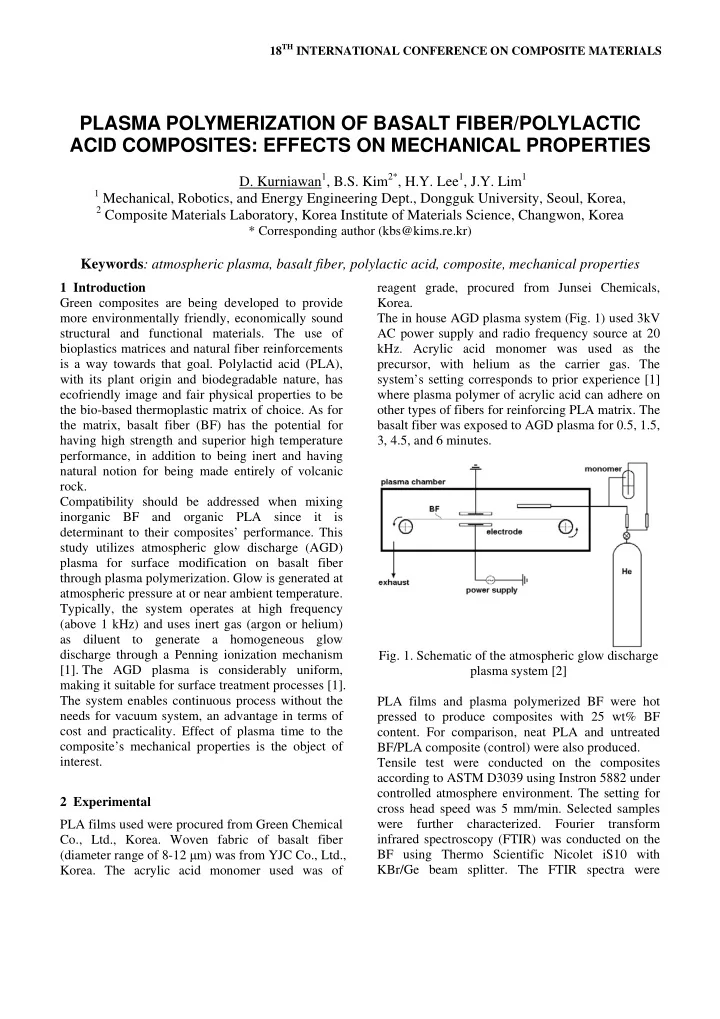

18 TH INTERNATIONAL CONFERENCE ON COMPOSITE MATERIALS PLASMA POLYMERIZATION OF BASALT FIBER/POLYLACTIC ACID COMPOSITES: EFFECTS ON MECHANICAL PROPERTIES D. Kurniawan 1 , B.S. Kim 2* , H.Y. Lee 1 , J.Y. Lim 1 1 Mechanical, Robotics, and Energy Engineering Dept., Dongguk University, Seoul, Korea, 2 Composite Materials Laboratory, Korea Institute of Materials Science, Changwon, Korea * Corresponding author (kbs@kims.re.kr) Keywords : atmospheric plasma, basalt fiber, polylactic acid, composite, mechanical properties 1 Introduction reagent grade, procured from Junsei Chemicals, Green composites are being developed to provide Korea. more environmentally friendly, economically sound The in house AGD plasma system (Fig. 1) used 3kV structural and functional materials. The use of AC power supply and radio frequency source at 20 bioplastics matrices and natural fiber reinforcements kHz. Acrylic acid monomer was used as the is a way towards that goal. Polylactid acid (PLA), precursor, with helium as the carrier gas. The with its plant origin and biodegradable nature, has system’s setting corresponds to prior experience [1] ecofriendly image and fair physical properties to be where plasma polymer of acrylic acid can adhere on the bio-based thermoplastic matrix of choice. As for other types of fibers for reinforcing PLA matrix. The the matrix, basalt fiber (BF) has the potential for basalt fiber was exposed to AGD plasma for 0.5, 1.5, having high strength and superior high temperature 3, 4.5, and 6 minutes. performance, in addition to being inert and having natural notion for being made entirely of volcanic rock. Compatibility should be addressed when mixing inorganic BF and organic PLA since it is determinant to their composites’ performance. This study utilizes atmospheric glow discharge (AGD) plasma for surface modification on basalt fiber through plasma polymerization. Glow is generated at atmospheric pressure at or near ambient temperature. Typically, the system operates at high frequency (above 1 kHz) and uses inert gas (argon or helium) as diluent to generate a homogeneous glow discharge through a Penning ionization mechanism Fig. 1. Schematic of the atmospheric glow discharge [1]. The AGD plasma is considerably uniform, plasma system [2] making it suitable for surface treatment processes [1]. The system enables continuous process without the PLA films and plasma polymerized BF were hot needs for vacuum system, an advantage in terms of pressed to produce composites with 25 wt% BF cost and practicality. Effect of plasma time to the content. For comparison, neat PLA and untreated composite’s mechanical properties is the object of BF/PLA composite (control) were also produced. interest. Tensile test were conducted on the composites according to ASTM D3039 using Instron 5882 under controlled atmosphere environment. The setting for 2 Experimental cross head speed was 5 mm/min. Selected samples PLA films used were procured from Green Chemical were further characterized. Fourier transform infrared spectroscopy (FTIR) was conducted on the Co., Ltd., Korea. Woven fabric of basalt fiber (diameter range of 8-12 μ m) was from YJC Co., Ltd., BF using Thermo Scientific Nicolet iS10 with Korea. The acrylic acid monomer used was of KBr/Ge beam splitter. The FTIR spectra were
recorded from 4000 to 600 cm − 1 with 2 cm − 1 The polymerization within the glow involved resolution, averaged over 32 scans. Thermal analysis metastable helium radicals (Penning reaction). This on selected samples was performed by differential reaction involves various reactive species, making it scanning calorimetry (DSC) using a Perkin-Elmer random in nature, and often forms polymers without DSC 7 set to scan from 20 to 180°C at the heating specific repeating unit. So, the macromolecules rate of 10°C/min under nitrogen atmosphere. The formed from the acrylic acid precursor are observed output was melting temperature ( T m ), heat designated as plasma polymer acrylic acid (ppAA). of fusion ( Δ H f ), and crystallinity of PLA and its composites. For morphology analysis, scanning electron microscope (SEM) JEOL JSM 5800 was used. 3 Results and Discussion Strength and stiffness of neat PLA and BF/PLA composites are displayed in Fig. 2. It is notable that untreated BF readily exhibits reinforcement effect to the composite. Short period of plasma polymerization on basalt fiber causes reduced strength and stiffness on the composites. Improvement, compared to untreated BF/PLA composite, was shown by composites whose BF was plasma polymerized for at least 3 minutes at the particular setting. The elongation at break of plasma polymerized BF/PLA composite also showed similar Fig. 2. Strength and stiffness of BF/PLA composites trend of decline for exposure time of up to 1.5 minutes and rebound afterwards. This decline on ( X is neat PLA) mechanical properties when BF was insufficiently exposed to AGD plasma was not unprecedented. Similar finding was reported on glass fiber/polyester composite where untreated glass fiber composite outperformed plasma polymerized glass fiber composite [3]. This study adds that prolonging plasma exposure time may help in getting the expected reinforcement effect. AGD plasma polymerized BF surface (Fig. 3) showed smoother appearance than BF as is. Untreated BF readily contains size, applied by the manufacturer to assist its processing and to improve its compatibility with specific matrix to promote strength, stiffness, and durability [4]. The size apparently suits fairly well with the PLA matrix. The distribution of size throughout fiber surface seems Fig. 3. Morphology of BF surface as received (a) uneven, with large portion is uncovered while some and plasma polymerized for 0.5 minute (b), 1.5 sites are overly applied. This uneven distribution minutes (c), and 4.5 minutes (d). seems common due to the high speed nature of fiber processing [4,5]. The longer the plasma The presence of ppAA on BF surface was detected polymerization occurred, the smoother the BF by FTIR through comparison with the spectrum of surface resulted. as received BF (Table 1). There was shift in C=O
Recommend
More recommend